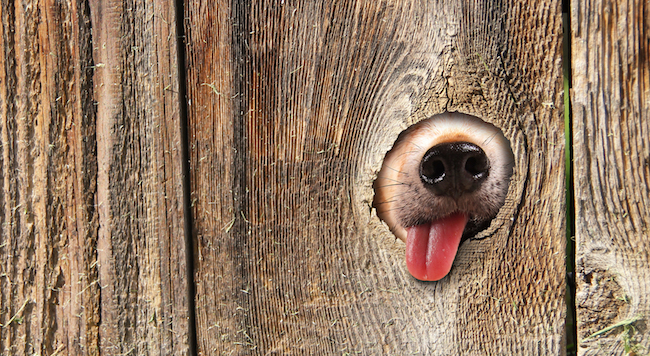
Whether your neighbor has a pesky Husky on the other side of the fence, or you have spotted coyotes prowling near your yard at night, even with physical barriers we can still feel vulnerable to intruders. Help fortify your boundaries with a few of these protective measures to keep the good dogs inside the yard, and the strangers out.
Ways to Keep Animals Out of Your Yard
Install a roller bar: For extreme cases where wild dogs or coyotes have attempted to jump over the fence to get in your backyard, installing a roller bar atop the fence will help keep them out. That way, anytime prying paws attempt to climb forward over the fence, the roller will rotate fluidly, causing them to lose traction and fall backward. For neighboring larger breeds, aggressive wild dogs & coyotes, or even wild cats, this is a superior method of protection.
Deep fencing: Build a fence around your yard that extends underground for several inches. Though this kind of lining might seem too extreme for most families, there are some areas that would benefit from building a partially embedded fence. This would be helpful if you raise chickens, or other vulnerable animals in your backyard, or if there are particularly aggressive predators who would be motivated to dig to get under your fence. Husky breeds, wolf mixes, or wild dogs and coyotes have been known to plow tirelessly into the ground in pursuit of a meal. If these are the challenges you face, consider installing a deeper fence.
Electric wire fencing or shock-wireless fences: These may not be the best method if there is a chance that children could cross the path and be hurt. If you are in an area where there are few children, or where kids are always supervised, using a shock fence ought to be accompanied with warning signs that surround the perimeter of your property. This will notify people to keep their distance, while affective keeping large animals out of your yard.
Plant-of-attack: If using an electric fence, (or building a higher/deeper fence) is simply not an option, sometimes planting thick hedges and thorny bushes might also be sufficiently protective barriers. A dog might think twice about digging ferociously by a bush whose thorns could stab him at every move.
Fear-tactic devices: There are also sprinklers and motion-sensing objects that will shoot out speedy streams of water in the direction of any intruder in the backyard. The dog may not know what is going on at first, but if he is easily frightened, a few sharp sprays might send him skedaddling back to where he came from. (If the animal is a larger breed, who might be inclined to size up the squirting machine before running away, there are also scarecrow sprinklers which will send out a sudden and heavy deluge to thoroughly dose a persistent animal.)
Odor deterrent sprays: When pet-parents use tools such as taste or odor deterrent sprays, they generally prove to effectively keep nosy canine neighbors at bay. However, no matter how much “Bitter Apple Spray” you spritz on the fence, plants, or across your yard, one night of heavy rainfall will require you to do the reapplication ritual all over again. This might be a great last-minute effort, but not an ideal long-term solution.
Front yard watch: If neighboring dogs are attempting to not only sneak in to your back yard, but are also leaving unsightly “land-mines” or in your front yard, it may be time to lay some ground rules. Some people post signs that say “Please pick up after your dog” in their front yard, while others even leave a weather-proof box of small plastic bags that dog-walkers can use to pick up the mess, should they forgot to bring their own. Not only does this measure leave no excuse when it comes to poop-scooping, but it also extends good will and hospitality to any passers-by.

